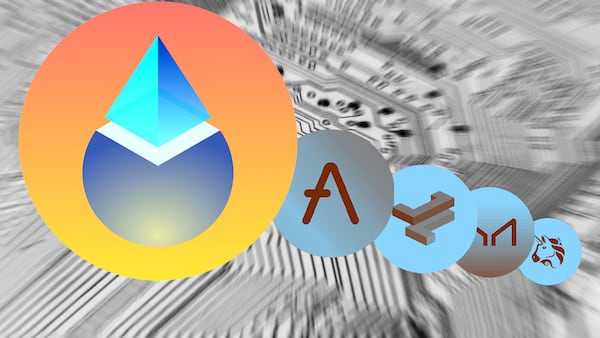- Liquid restaking providers are building a '10-lane highway' into EigenLayer.
- Their approach evokes liquid staking, the biggest business in Ethereum.
- Although they offer investors greater rewards, they also come with greater risks.
- 'Everybody is worried' about a LUNA-style collapse, says one DeFi builder.
A new kind of token is gathering steam on Ethereum.
It has the potential to turbocharge the blockchain’s ecosystem or leave behind a smouldering ruin if its developers aren’t careful.
The market capitalisation of liquid restaking tokens, which track the price of Ether, was just over $400 million Tuesday, according to data compiled by Hashed, a 400% increase since mid-December.
Only three liquid restaking tokens are live: Ether.Fi’s eETH, KelpDAO’s rsETH, and Renzo’s ezETH. But at least eight more are running on test networks and are expected to launch in the coming months.
“They see ‘LRT’ and they think it’s the same thing as a liquid staking token,” said Lucas Kozinski, a founding contributor to liquid restaking protocol Renzo, referring to an earlier class of token widely used in DeFi.
“But they don’t actually understand the economics of it.”
A ‘new primitive’
Liquid restaking is often compared to liquid staking, the biggest business on Ethereum. Liquid staking protocols hold more than $32 billion in user deposits, according to data from DefiLlama.
Still, the comparison is apt. Both eliminate the opportunity cost that comes with “staking,” locking away one’s tokens to secure Ethereum in exchange for a modest annual yield.
That yield is often lower than the return investors can earn elsewhere in DeFi, for example by lending their tokens.
Liquid staking and restaking protocols address the opportunity cost by issuing IOUs for staked tokens.
‘That’s why restaking actually makes a lot of sense, because, well, you should let people get further out on the risk curve.’
— Mike Silagadze, EtherFi
Those IOUs — known as liquid staking or liquid restaking tokens — can then be used across DeFi as if they were the staked tokens, a win-win for Ethereum and for users leery of locking away tokens when there are more lucrative ways to use them.
That’s where the similarity ends.
Liquid staking tokens, such as Lido’s stETH or Rocket Pool’s rETH, have relatively few risks — at least when compared to most other DeFi protocols with complex smart contracts. All told, there are relatively few machines, people or lines of code needed.
A user entrusts their Ether to individuals and organisations called node operators, who, in turn, run so-called validator software to participate in the confirmation of pending transactions on Ethereum.
If an incompetent or malicious node operator misbehaves, some of the Ether is destroyed in a process called “slashing.” This is rare, however: only 1 Ether has been slashed since the current iteration of Ethereum launched, according to Rated.
Risk curve
Some foresee a future in which all Ether is locked away generating its modest yield, replaced in the marketplace by IOUs in the form of stETH and its competitors.
The relative safety of staking is reflected in that yield: just under 4% last Friday, a number that will drop as more Ether is staked.
“That’s why restaking actually makes a lot of sense, because, well, you should let people get further out on the risk curve,” Mike Silagadze, of liquid restaking provider Ether.Fi, told DL News.
“What if you’re okay taking a 1% risk [of slashing] in exchange for much higher rewards?”
Liquid restaking tokens are expected to increase in number this year. They use the EigenLayer protocol to help bootstrap any number of other protocols, each with its own level of security. Investors earn Ethereum staking yields as well as yield from bootstrapping a basket of other protocols that use EigenLayer.
The next ‘Luna catastrophe’?
The safety — and the outsize yield — of liquid restaking tokens will be determined by how well liquid restaking providers manage the basket of protocols they validate.
“On Ethereum mainnet, the marketplace for liquid staking is structurally very different [than for liquid restaking], because there’s only one strategy you could run,” Kozinski said.
‘But it’ll end the bull [market] when a Luna catastrophe happens, because no one cares about risk management.’
— Tze Donn Ng
“But when you have all the different strategies that you could run [with liquid restaking] … it’s actually a brand-new DeFi primitive that doesn’t exist, and that’s portfolio management.”
Not everyone is convinced this is a positive development.
Restaking will kickstart the next bull market because of its high APYs and novel technology, Tze Donn Ng, an investment associate at venture capital firm Tioga Capital, told DL News.
“But it’ll end the bull [market] when a Luna catastrophe happens, because no one cares about risk management,” he added.
Attractive, but unsustainable, yields available on the Terra/Luna blockchain drew investors during the 2021 run that saw most major cryptocurrencies hit all-time highs. Terra’s collapse in May 2022 helped plunge the crypto economy into a deep freeze.
“Everybody’s worried about that,” Kozinski said when asked about the Terra analogy.
EigenLayer
When EigenLayer launched in June, it became the first protocol to offer “restaking.”
Restaking allows users to stake Ether or their staked Ether — not to secure Ethereum, but to bootstrap protocols that would otherwise have to run on their own networks, such as the bridges that allow users to transfer tokens between blockchains.
In exchange, the protocols that use EigenLayer pay restakers, boosting the safe but modest yields people can earn from old-fashioned staking.
Subchains and L2s
Proponents say this will dramatically reduce the cost of some protocols, including bridges, other blockchains, oracles, and diverse technologies critical to the crypto ecosystem.
“I believe that in the next two years we are going to see more non-crypto businesses onboard into web3,” Dheeraj Borra, from liquid staking protocol Stader, said in an X Spaces appearance last year.
“Restaking is going to be a great platform for them to create subchains and L2s, with most [liquid staking tokens] becoming active collateral for these chains.”
Others, like Ethereum founder Vitalik Buterin, warn it’s a business model that could cause systemic risk if providers aren’t careful.
Either way, liquid restaking providers are trying to usher in this future.
“At the end of the day, we’re trying to build a 10-lane highway to make it super convenient and efficient for that capital to flow in and out of EigenLayer,” Kozinski said.
As the market matures, observers predict liquid restaking tokens will integrate with the broader DeFi ecosystem and be used as collateral to borrow other crypto, mint stablecoins, and more.
Risk management
Whether that happens will depend on risk management.
Chunda McCain, founder of Ion Protocol, a lending platform for restaked assets, also likens liquid restaking providers to portfolio managers, or platforms for portfolio managers. Ion, whose test network launched last week, is attempting to develop tools to analyse liquid restaking providers’ risk profiles.
“I was like, ‘We’re going to build a lending protocol,’” McCain told DL News. “And then I realized, ‘Wait, in order to build a lending protocol, you need to do all the underwriting.’”
The returns from restaking will flow from the protocols that use EigenLayer, which EigenLayer calls actively validated services, or AVSs.
‘You’re effectively putting all of that trust into whoever’s running the strategy of the LRT provider.’
— Chunda McCain
Liquid restaking providers will have to become expert at assessing the risk of various AVSs. And the variety of investment strategies is almost endless.
With three AVSs, restakers are presented with seven possible investment strategies. Fifteen AVSs provide more than 30,000 possible strategies. Liquid restaking providers must price risk appropriately to ensure their users are not left holding the bag if an AVS goes under.
“The goal of an LRT is to say, ‘OK, I understand the profit potential of all these different platforms. … [and] to make sure I can offer the users who want to participate in the restaking ecosystem maximal returns with minimised risk,” McCain said.
“You’re effectively putting all of that trust into whoever’s running the strategy of the LRT provider.”
Restaking stack
He said he worries that an irresponsible liquid restaking provider will offer users massive yields despite poor risk management, attracting so much money it will become a systemic risk.
“Someone will most likely build this,” he said.
Risk can come from every layer of the liquid restaking stack.
Because restaking yield comes, in part, from tokens issued by AVSs, restakers can be harmed if an AVS introduces poor tokenomics.
‘Leverage on top of leverage’
Risk can come from node operators that get slashed. And it can come from newer DeFi protocols that allow people to lend and borrow or mint stablecoins against LRTs.
Additionally, risk can come from old-fashioned bugs in liquid restaking protocols’ smart contracts. Earlier this year, liquid restaking protocol Astrid was hacked and has been paused since.
But providers can learn from DeFi lending protocols, according to Kozinski. Liquid staking and liquid restaking protocols are essentially lending protocols, he said.
“This is leverage on top of leverage on top of leverage on top of leverage on top of leverage.”
If they succeed at managing risk, they could become some of the most popular tokens on Ethereum.
“I don’t think liquid restaking is another category. I think liquid restaking is just going to become table stakes for liquid staking,” Silagadze said. “I don’t think you’re going to have pure, vanilla liquid staking tokens even, like, two years from now.”
Update, Jan 17: This article was updated to correct a comment from Lucas Kozinski regarding lending protocols.
Aleks Gilbert is DL News’ New York DeFi correspondent. Have a tip? Contact him at aleks@dlnews.com.







